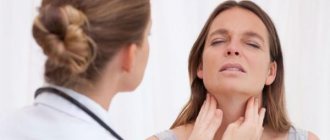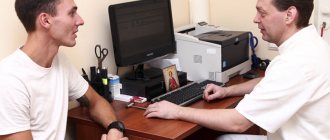What is vegetative-vascular dystonia?
Vegetative-vascular dystonia (VSD)
) is a malfunction in the functioning of the whole organism. By and large, this is not a disease, but a malfunction of the autonomic nervous system, a violation of the regulation of the dynamic constancy of the internal environment of the body and the stability of its basic physiological functions: breathing, blood circulation, digestion, thermoregulation, metabolism, excretion, reproduction, etc. This is a functional failure of the body that can turn into disease.
VSD is a very common disease. About half of all women and a fifth of men are susceptible to autonomic dysfunction syndrome. Complaints can be very diverse: patients complain of weakness, pain in the heart area and under the left shoulder blade, headache, pressure surges and neurological disorders. If no measures are taken, the patient only gets worse. In the future, more serious surges in pressure, disruption of brain function and panic attacks are possible - acute stressful conditions characterized by a serious disturbance in a person’s mental state. If left untreated, functional disorders of VSD can cause more serious diseases, such as hypertension.
Quite often, vegetative-vascular dystonia is situational in nature: this means that an exacerbation of symptoms occurs against the background of stress, during weather changes, menstruation or other ordinary situations.
To date, doctors have described about 150 symptoms and 32 syndromes of clinical disorders with the diagnosis of “vegetative-vascular dystonia”. This is too much for an accurate diagnosis of any disease, and this is why diagnosing VSD is very difficult.
Many patients do not understand what serious consequences vegetative-vascular dystonia can lead to. Unfortunately, feeling unwell and having headaches is considered a “habitual” occurrence that can be alleviated with painkillers.
The availability of medications does its job: it’s easier to go to the pharmacy and relieve pain with pills, but medications only eliminate the symptoms of VSD and have nothing to do with treatment.
The mechanism of development of vegetative-vascular dystonia is as follows: in a normal state, the autonomic nervous system regulates the activity of internal organs, ensuring their adequate response to processes occurring in the body. In turn, the activity of the human autonomic nervous system is regulated by two subsystems: parasympathetic and sympathetic.
The parasympathetic subsystem is responsible for sleep and restoration of the body's strength, and the sympathetic subsystem is responsible for the period of wakefulness. Their work “alternates,” allowing a person to expend energy during the day and recover at night, during sleep and rest. The systems are closely connected to the brain and spinal cord and their failure affects the activity of the entire nervous system. The disruption of the relationship between these subsystems and the body’s incorrect response to natural processes is called vegetative-vascular dystonia. Since we are talking about malfunctions of the nervous system, VSD is very difficult to diagnose. The patient visits several specialists without success, but his condition continues to worsen. At the same time, the test results or cardiogram are in perfect order, but the patient feels worse and worse.
Means for reducing blood pressure
The following medications will help to urgently reduce high blood pressure:
- Kapoten. Effectively lowers blood pressure, eliminates extrasystoles and relaxes blood vessels. Many VSD sufferers even note that Kapoten also fights well against adrenaline crises, although this is only a psychological moment: when the pressure begins to decrease, the patient consoles himself - and the panic attack passes. The main thing is not to overdo it with the dosage. With blood pressure up to 140/100, it is better not to take such a “powerful” drug. But if such pressure is still critical for you, you can put ¼ tablet under your tongue. In cases of higher levels, take ½ or a whole tablet. An overdose is fraught with a sharp decrease in blood pressure and loss of consciousness.
- Andipal. A light, soft drug that is taken in a dosage of 1-2 tablets, washed down with plenty of water. Suitable for reducing blood pressure up to 140/100. The effect, however, occurs only after 20 minutes - during this time the attack itself can end safely. But it is very common for a VSD person to have a “placebo” on hand.
- Corvalol (drops). These drops are based on phenobarbital, which puts the brakes on the entire central nervous system, at the same time reducing blood pressure. But with high blood pressure levels (above 140/100), Corvalol is unlikely to provide quick help. At the time of an attack, you can drink up to 40 drops of the drug, but you should not abuse it. The body quickly gets used to “good things”, and soon blood pressure will no longer be “afraid” of Corvalol.
Symptoms of vegetative-vascular dystonia?
The symptoms of autonomic dysfunction are very diverse: the patient’s condition is characterized by a variety of symptom complexes. Symptoms appear against the background of physical and mental stress, family worries, problems at work and general weakness of the body. Most often, VSD is characterized by vague pain in the heart, sweating, rapid heartbeat, a feeling of shortness of breath and fluctuations in blood pressure. The painful condition may be accompanied by fear, weakness, trembling in the limbs, slight dizziness, irritability, anxiety, tinnitus and decreased appetite - even fainting and sudden emotional swings. These symptoms can be the cause of a variety of diseases. The diagnosis of VSD is made by excluding those diseases that the patient complains of. If the patient’s complaints are not confirmed by the examination results, the doctor excludes a specific disease and continues to look for the cause of the ailment. If consistent work based on the patient’s complaints and examination results does not allow one to draw a specific conclusion about the causes of the disease, the doctor makes a diagnosis of VSD. One of the most well-known symptoms of VSD is meteorological dependence - the patient feels unwell when the weather changes.
Criteria for diagnosing VSD
In order to reliably diagnose vegetative-vascular dystonia, the doctor must detect symptoms that are often found in this disease and exclude other pathologies. Neurologists are usually guided by the following criteria:
- A patient with VSD presents many different complaints. First of all, they relate to disruption of the cardiovascular system.
- The patient suffers from the disease for quite a long time. Exacerbations occur periodically, during which the symptoms intensify.
- There are no serious complications, heart failure.
- There are a lot of complaints, but during the examination one gets the impression that the person is healthy.
- The diagnosis of VSD cannot be made if the following signs are present: an increase in heart size, heart murmurs, pronounced changes in the ECG, an inflammatory process in the body (detected by the results of general and biochemical blood tests), heart failure.
In these cases, it is necessary to continue the diagnosis and look for the true cause of “vegetative-vascular dystonia”.
Types of vegetative-vascular dystonia
Vegetative-vascular dystonia is manifested by many symptoms, varying in nature and intensity.
Based on patient complaints and doctors’ experience, several types of vegetative-vascular dystonia can be classified, among which the following types are the most common:
VSD of mixed type:
the patient complains of headache, nervousness, anxiety and fear, dizziness and changes in heart rate.
VSD according to cardiac type:
the predominance of complaints of pain in the area of the heart and left shoulder blade, rapid heartbeat. In this case, blood pressure can deviate either upward or downward, or be stable.
VSD according to the vagotonic type:
causeless abdominal pain, nausea, lack of appetite, digestive problems. The patient may complain of insomnia, increased swelling, fatigue, sweating and psychological sensitivity.
VSD of the hypertensive type:
one of the most common types, when the disease occurs with high blood pressure. Most often, the patient complains of headaches, nausea and dizziness.
VSD of hypotonic type:
manifests itself in the form of weakness, increased sweating, and is characterized by decreased ability to work. In this case, blood pressure is steadily reduced.
Each type of VSD has its own symptoms of the disease and their list is quite extensive. To one degree or another, the initial signs of vegetative-vascular dystonia are present in every person and most people simply do not pay attention to them. If you have a headache, you take medicine, but the true cause of the ailment remains unclear.
This is the main danger of vegetative-vascular dystonia. Lack of proper treatment and self-medication leads to the progression of VSD: gradually the whole body is involved in the process, and if no action is taken, the disease has consequences on the internal organs. Over time, it becomes more and more difficult for a person to maintain a comfortable rhythm of life: the manifestations of the disease become more acute, and more and more medications are required to relieve symptoms.
In an advanced stage, vegetative-vascular dystonia leads to kidney problems, varicose veins, thrombosis, as well as a significant increase in the risk of heart attack. In the chronic stage, VSD leads to complete disability and causes serious mental illness.
Systematizing all cases, doctors conclude that the following factors can cause the disease:
- Hereditary constitutional factor: the likelihood of VSD increases if one of the parents suffers from this disease. In addition, those people who grew up in single-parent families, or where they were raised in an environment of frequent quarrels and scandals, are more susceptible to the disease.
- Psychophysiological changes that can occur due to stress, heavy physical or intellectual work. There is a high probability of the occurrence and development of VSD against the background of viral infections, alcohol abuse and smoking. Chronic stress, alcohol abuse and smoking contribute to the deterioration and progression of the condition. The most likely causes of vegetative-vascular dystonia may be the inability to rest and relax after hard work, a sedentary lifestyle or a violation of the daily routine. We can draw the following conclusion: everything that weakens the immune system and does not benefit the body can cause the development of vegetative-vascular dystonia.
- Hormonal changes: VSD can occur during puberty and during menstruation.
- Organic somatic diseases: the disease is aggravated by diseases of the heart and blood vessels, respiratory system, liver dysfunction, gastrointestinal tract and processes affecting mental activity; VSD can occur against the background of viral infections and disorders of the musculoskeletal system - problems with the spine often coexist with autonomic dysfunction.
- Diseases of the nervous system: VSD accompanies many diseases of the nervous system.
- Occupational diseases: physical factors of the working environment - electromagnetic radiation, increased noise levels, foreign odors, etc. – can cause VSD.
- Neuroses: one of the most common factors causing the manifestation of autonomic dysfunction syndrome.
- Mental illnesses: cause emotional and personal disorders, which also provoke the onset and course of VSD.
From the above it is clear that there are many reasons for the occurrence of vegetative-vascular dystonia.
Symptoms of autumn exacerbation of VSD
In autumn, nature fades, colors fade, everything around becomes gray. The temperature drops, it becomes cold, damp, dank.
A person with VSD sees the extinction of nature, he is increasingly visited by negative thoughts, diseases worsen, there is weakness and general apathy.
You may also be interested in:
Common myths about panic attacks
This is how a forum participant about vegetative-vascular dystonia describes the autumn exacerbation:
“Since October, my depression has been getting worse, all the symptoms of VSD, it seems to me that I will die or get a fatal disease. Nothing is interesting, just a premonition of death. I always look forward to the autumn-winter period.”
Many other neurotics experience something similar.
What symptoms are characteristic of the autumn recession?
Exacerbation manifests itself as follows:
- Fears, thoughts of imminent death. A person begins to fear diseases, crowds, infection and everything in general. This state is described as “existential fear.” Fears are accompanied by palpitations and general depression (panic attacks). Research shows that thoughts of death come to a person when the cardiovascular system is disrupted.
- Insomnia and sleep disturbance . Autumn worsens insomnia, it is difficult to fall asleep, sleep is very superficial. After such a rest there is no vigor, only fatigue.
- Anxiety. Many compare the exacerbation of VSD in the autumn season with a feeling of emptiness. An anxious state is close to fear; a person expects something unpleasant, worries about possible terrible events. However, there is no real threat to this.
- Asthenic syndrome . It includes irritability, headache, memory impairment, loss of appetite. Asthenia provokes an exacerbation of diseases, thereby worsening the general well-being of a person with VSD.
- Dizziness . Vascular insufficiency in vegetative-vascular dystonia is characterized by a drop in blood pressure, general weakness, pallor of the skin, and a slow pulse. Dizziness is often caused by changes in weather conditions, when temperatures jump, and indicates poor circulation.
What other symptoms may indicate an autumn recession? An exacerbation is sometimes characterized by pain in the left half of the chest, a slight increase in temperature, arrhythmia, severe shortness of breath, autonomic skin disorders, and loss of strength.
The severity of symptoms and their variety depend on the individual and the degree of functional disorder. The more a person is immersed in his “illness,” the worse he will feel.
If your health suddenly worsens, the first thing you should do is consult a doctor. Do not forget that the symptoms of vegetative-vascular dystonia are similar to the symptoms of many other diseases.
It is necessary to undergo an examination and make sure that you definitely have dystonia and neurosis, and not a real somatic disease.
Only when the diagnosis of VSD is confirmed by a qualified specialist can self-help methods be considered.
Online appointment with a doctor in any city in Russia
What can help when an autumn exacerbation worsens your health, and the symptoms of VSD worsen your life? Let's look at some effective ways to combat it.
Phytotherapy
For dystonia, herbal medicine has a very good effect on the body and well-being. Do not forget that any herbs have their contraindications. And before taking them, you need to make sure that you do not have these contraindications.
It is also worth considering that herbs have an effect with regular and long-term use.
Decoctions from:
- Valerian roots
- Motherwort
- Oregano
- Daisies
- Thyme
- Mint
- Hop cones
All these plants have a relaxing effect and have a beneficial effect on the nervous system.
If you don’t have time to brew herbs, you can drink ready-made infusions of valerian, motherwort, and peony.
The average duration of herbal medicine is 3-4 weeks.
Massage
To cope with loss of strength, you can use massage of active points.
- The first point is in the center of the back of the hand. We take a deep breath and, as we slowly exhale, massage the point and ring finger. The manipulation must be done 10 times.
- The second point is located 5 cm below the navel. It is massaged for about 2 minutes with the index finger.
- The third point is located midway between the bases of the thumb and index fingers. A ball is applied to it and circular movements are made. The optimal number of movements is 30 times for each hand.
Massage sessions with a professional will also be beneficial. If possible, it is worth taking a course of a relaxing massage. It will help relieve muscle spasms, improve blood circulation, and your condition will immediately change in a positive direction.
Instead of associating autumn with negative experiences, look at it differently. Try to think about how cozy it is instead of thinking about the cold and rain.
Music therapy
Music therapy helps to get rid of depression, autumn blues, and fear of death. Music affects a person through vibration and rhythm. Each vibration affects certain human organs. Doctors have drawn the following patterns:
- Cello has a healing effect on the genitourinary system.
- The organ has a positive effect on the entire body.
- The flute helps fight apathy and depression, the aggravation of which is so noticeable in the fall with VSD.
- A violin affects a person like a flute, but its effect is several times stronger.
- The bell is considered the most powerful instrument of music therapy.
You can simply listen to your favorite music that evokes positive emotions in you. It is advisable to do this every day, at least 15-20 minutes.
Meditation
During the autumn exacerbation of VSD, meditation is a very useful practice. It has been known since ancient times and is used by almost everyone involved in healing, self-knowledge, and self-development. Scientists have long proven the colossal healing power of meditation. Today, meditation is recommended not only by esotericists, but also by psychologists, psychotherapists, and doctors.
The main essence of meditation is concentration and observation.
If you have never encountered this topic and do not know how to meditate, study the information and choose the best method for yourself.
Remember that there is no right or wrong meditation. There is only what is right or wrong for you.
You can meditate on anything - internal images, visual pictures, music, words, etc. The main thing is that you feel comfortable.
It’s enough to start with 3-5 minutes a day and gradually increase the time.
Meditation is one of the best ways to strengthen your nervous system and free your mind from worries.
Healing Fitness
With vegetative-vascular dystonia, fatigue is often felt. This condition worsens in the fall.
Doctors recommend using exercise therapy exercises to increase physical tone. Paradoxically, after physical activity, blood pressure normalizes, painful sensations disappear and emotional reactions improve.
Yoga is also very useful for VSD. It is especially suitable for those who find it difficult to perform cardio exercises and who do not tolerate too intense exercise.
Yoga, better than other gymnastics, strengthens the spine, relaxes muscles, tones, improves immunity and overall well-being.
In autumn, nature freezes, and some animals hibernate. Following them, a person slows down, becomes lethargic, lazy and, as a result, often sad. Since we won’t be able to fall asleep until spring, there is a way out of the sad state. This is movement. Thanks to active physical activity, the body's metabolism accelerates, vigor and a real feeling of one's body appear, instead of the sad sniffling of a seal under a blanket.
How to treat vegetative-vascular dystonia with the ALMAG-01 device
IMPORTANT: the ALMAG-01 device can only be used for the treatment of VSD due to hypertension. Treatment must begin after the acute phase of the vegetative crisis.
THE DESIGN OF ALMAG-01 INCLUDES THE FOLLOWING ELEMENTS:
Physiotherapeutic procedures with the ALMAG-01 device are carried out once a day. The standard course of treatment lasts three weeks: after every six days, a one-day break is required. The course of treatment is 18 procedures. A repeated course can be carried out after 30-40 days, and a maintenance course - 3-4 months after completion of treatment.
The treatment procedure is simple and does not require special knowledge. Inductor coils are sequentially applied to the projection area of the adrenal glands and the collar zone, and the exposure time is set according to a table developed by specialists.
Fortunately, vegetative-vascular dystonia is a curable disease. To do this, it is necessary not only to undergo treatment, but also to change your lifestyle, reconsidering your views on your daily routine, rest and physical activity.
Diagnosis of VSD in adults: instrumental studies and analyzes
If you suspect vegetative-vascular dystonia, a neurologist may prescribe the following studies and laboratory tests:
- General and biochemical blood tests . With vegetative-vascular dystonia, no pathological changes are detected in them. They are needed in order to exclude inflammatory diseases, for example, rheumatic carditis .
- Chest X-ray . In the pictures, the heart, aorta and other large vessels have normal sizes with VSD - this indicates that there are no heart valve defects.
- Electrocardiography . During the study, changes are revealed that may resemble coronary heart disease. However, they are not stable and change during tests with physical activity and the administration of medications. Sometimes, with vegetative-vascular dystonia, extrasystoles - extraordinary contractions of the heart muscle. However, they do not arise due to pathology of the heart, but are caused by a mismatch in the functioning of the nervous system.
- Ultrasound of the heart . Allows you to eliminate valve defects. With VSD, mitral valve prolapse may be detected.
As can be seen from the list, the diagnosis of VSD is aimed primarily not at detecting any changes characteristic of a given disease, but at excluding other pathologies.
We are proud of the team of neurologists - experienced professionals - that we managed to assemble at the Medical Center International Clinic Medica24. You will be carefully examined, the doctor will not miss anything, because all our doctors work according to the same standards developed by experts. Clinic administrators are ready to take your call at any time of the day.
Get a consultation with a doctor
Message sent!
expect a call, we will contact you shortly
Therapeutic effect of ALMAG-01 in the treatment of VSD
The running pulsed magnetic field of the ALMAG-01 device improves blood circulation in the affected area, increases the activity of cells and the endocrine system, which has a positive effect on the production of hormones and enzymes. And this, in turn, allows you to normalize the functions of the human cardiovascular and nervous systems. The device has a general calming effect.
The use of the ALMAG-01 device for the treatment of VSD can significantly reduce the intake of medications, or even do without their use, and prevent the development of hypertension.
Exposure to the zone of a traveling pulsed magnetic field reduces vascular tone, the opened capillaries begin to let more blood through and trigger the mechanism for restoring metabolic processes.
The magnetic pulses of the device penetrate deep into the tissue and are able to have a complex effect on all tissue capillaries. Normalizing blood circulation and metabolic processes can improve the quality of sleep, the general well-being of the patient and relieve the main symptoms characteristic of attacks of VSD.
In the ALMAG-01 device there is no problem of the patient getting used to the physiological procedure: sequential activation of the field generators allows you to create the effect of a “running” field, and the constant change in the intensity of the inductor coils does not allow the body to get used to the therapeutic effect.
Consequences and complications
Along with the classic symptoms and diseases accompanying vegetative-vascular dystonia, the patient’s condition can be worsened by frequently occurring (approximately 50%) vegetative crises - sympathoadrenal, vagoinsular and mixed (depending on the predominance of disorders of a particular part of the system).
Sympathoadrenal crisis. The development of a so-called panic attack is associated with a sharp release of adrenaline. The crisis begins with a sudden headache, rapid heartbeat, and paleness/redness of the face. Arterial hypertension, chills, tremors, numbness of the extremities, and anxiety are usually observed. The attack also ends suddenly and is accompanied by asthenia and polyuria (increased urine production).
Vagoinsular crisis. Its symptoms are almost the opposite of sympathetic manifestations. The crisis begins with the release of insulin into the blood and a sharp decrease in glucose levels. The activity of the digestive system increases, intestinal motility increases, and rumbling appears in the stomach. A vagoinsular attack is characterized by a feeling of cardiac arrest, dizziness, arrhythmia, and difficulty breathing. Blood pressure decreases, the pulse becomes rare, sweating, skin flushing, and darkening of the eyes appear. The patient feels weak throughout the body. The attack ends with a state of severe asthenia.
Mixed crises are characterized by activation of both parts of the autonomic nervous system and, consequently, all of the listed complications. As a rule, in the absence of timely treatment of VSD, rather unpleasant consequences arise. This is especially true for childhood, since psychosomatic pathologies often appear during this period of development. These consequences are quite difficult to correct. VSD is not a life-threatening disease, but over time its quality can significantly decrease. If such severe symptoms of vegetative-vascular dystonia persist in adulthood, poor adaptation is observed, and it becomes impossible to fully work and study.
Advantages of the ALMAG-01 device in the treatment of VSD
- ALMAG-01 improves microcirculation and normalizes blood pressure. Even at the initial stage of treatment, the patient's increased vascular tone decreases and blood circulation improves.
- Eliminates the main cause of VSD - normalizes a person’s mental state.
- By reducing the sensitivity of peripheral nerve receptors, the device has a calming effect and restores sleep quality.
- Treatment allows you to normalize blood pressure, and in the case of tachycardia, reduce the heart rate.
- The course of treatment does not require special knowledge and can be carried out by the patient independently, at home.
- The device is able to enhance the effect of medications used and even completely eliminate them.
Differential diagnosis of VSD
Differential diagnosis of vegetative-vascular dystonia most often has to be carried out with the following diseases: coronary heart disease (CHD), infectious-allergic myocarditis, rheumatism, cardiomyopathies.
During diagnosis, a neurologist focuses on the patient’s complaints, examination data, examinations, and test results. All symptoms must be carefully assessed.
The international clinic Medica24 employs experienced neurologists and uses new, modern diagnostic equipment. This allows you to establish a reliable diagnosis as quickly as possible and immediately begin effective treatment. We have medical assistance available around the clock.
The material was prepared by a cardiologist, geriatrician, therapist, professor, Honored Doctor of the Russian Federation, Doctor of Medical Sciences at the international clinic Medica24 Yuri Evstafievich Serebryansky.
Diagnostics
To begin with, the doctor, during a conversation with the patient, collects a detailed anamnesis - finds out the complaints, their nature, frequency of occurrence, the presence of a hereditary factor (are there people in the family who suffer from confirmed VSD).
Then a general examination is carried out, attention is paid to the patient’s behavior and his emotional background.
Due to the presence of symptoms similar to those of various other diseases (arrhythmia, hypertension, pathologies of the thyroid gland, gastritis, etc.), each patient with suspected VSD must undergo a detailed therapeutic examination in a clinical setting. To confirm the diagnosis of VSD, it is necessary to absolutely exclude diseases with similar symptoms. For this purpose, laboratory tests are prescribed:
- general blood analysis;
- general urine analysis;
- liver and kidney function indicators;
- analysis of thyroid hormone levels;
- clarifying tests at the discretion of the doctor.
Next, a referral is given for instrumental examinations, of which the most frequently used are:
- electrocardiography (ECG);
- echocardiography;
- 24-hour Holter blood pressure monitoring;
- fibrogastroduodenoscopy;
- Ultrasound of the abdominal organs, kidneys, neck vessels, thyroid gland;
- chest x-ray;
- spirometry;
- bicycle ergometry.
Sometimes the doctor requires additional diagnostic methods, such as computed tomography (CT), magnetic resonance imaging (MRI), electroencephalography, colonoscopy and others. Various functional tests are also carried out (psycho-emotional, orthostatic, physical exercise, pharmacological).








